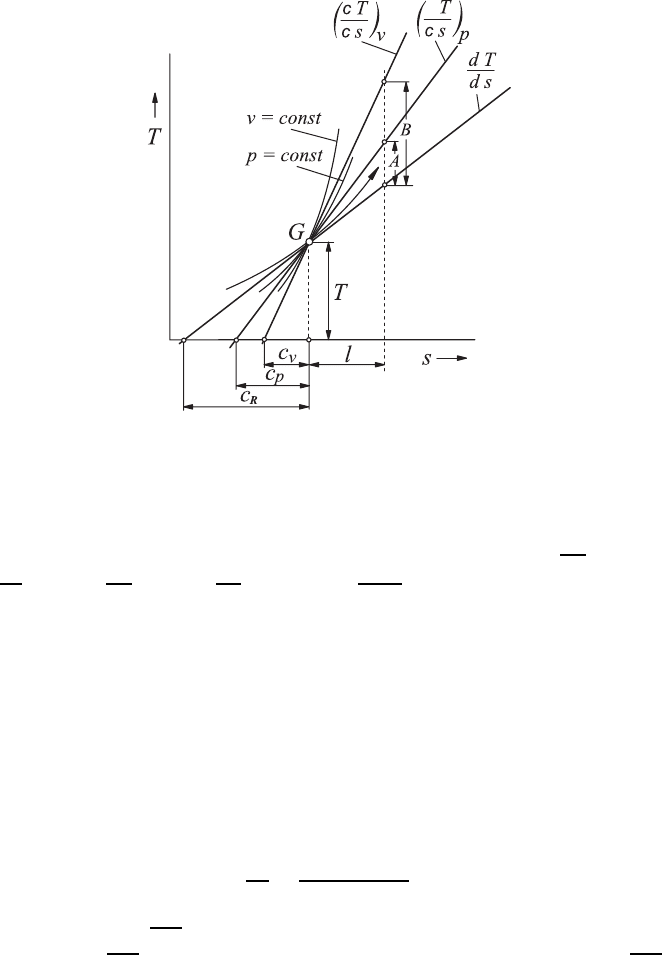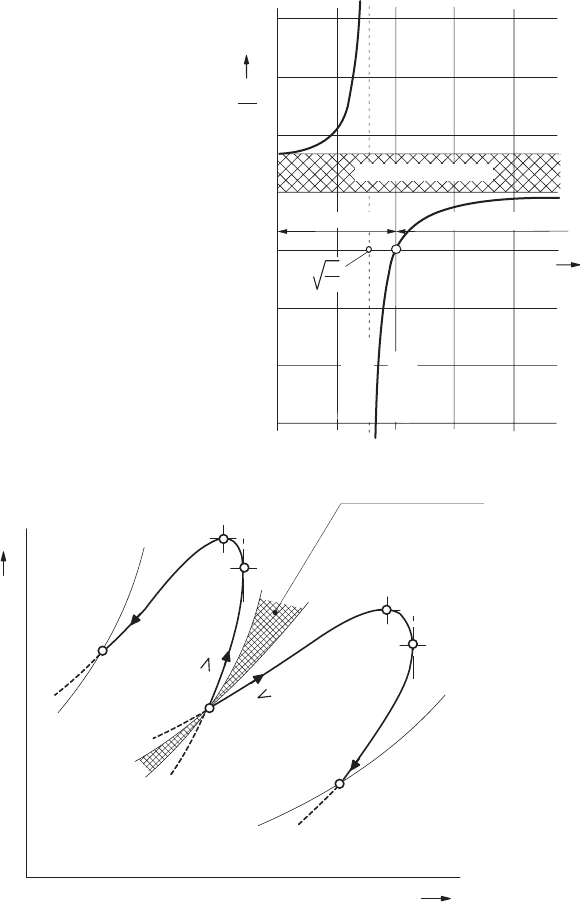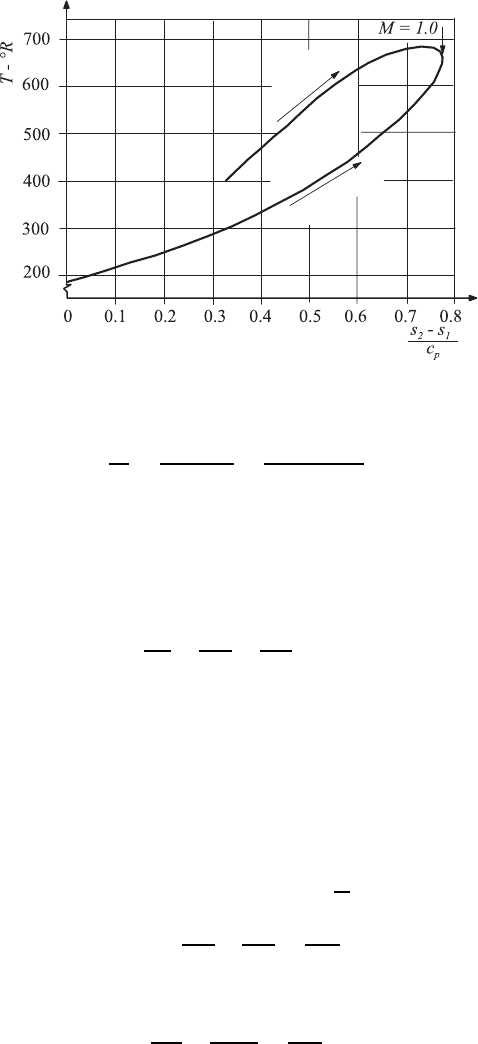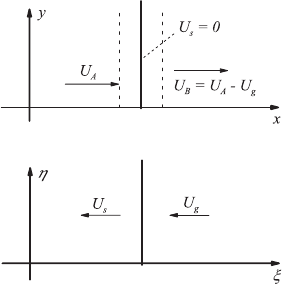Durst F. Fluid Mechanics: An Introduction to the Theory of Fluid Flows
Подождите немного. Документ загружается.


12.5 Flow with Heat Transfer (Pipe Flow) 349
Fig. 12.11 Change of state in the T–s diagram for pipe flows with heat supply
that (12.89) holds not only for flows of ideal gases, generally treated in gas
dynamics, but also for the flows of real gases.
In conclusion, it can be remarked that the relationships for
dU
U
(12.74),
dρ
ρ
(12.75),
dP
P
(12.76),
dT
T
(12.76) and
dMa
2
Ma
2
(12.78) for Ma =1losetheir
validity if (dq) = 0. In order to accelerate a subsonic flow to supersonic flow
speeds through heat supply, the heat supply has to be stopped once Ma =1
is reached. After that, it is necessary to cool the flow in order to obtain a
further velocity increase.
Extended considerations show that the heat supply in the subsonic region
leads to accelerating the flow and in the supersonic region to decelerating the
flow. For pipe flows with a radius R = constant, a subsonic flow cannot be
turned into a supersonic flow with constant heat supply.
By considering the course of the effective heat capacity of the pipe flow,
the behaviour shown in Fig. 12.12 results:
c
R
c
v
=
(Ma
2
− 1)
(Ma
2
− 1/κ)
. (12.90)
For 0 ≤ Ma <
1/κ and 1 ≤ Ma < ∞ the heat capacity is positive and in
the range
1/κ < Ma < 1 a negative heat capacity results. At Ma =
1/κ
the local flow velocity has the value of the isothermal sound velocity.
According to (12.88) for the effective heat capacity c
R
/c
v
in heated and
cooled pipe flows, the thermodynamic state developes as shown in Fig. 12.13.

350 12 Introduction to Gas Dynamics
Fig. 12.12 Behavior of the effec-
tive heat capacity of a gas with heat
supply in a pipe flow
c
v
p
=
c
c
=
c
c
v
c
Forbidden region
Subsonic
Supersonic
T
1
2
x
1
x
1
2
3
4
0
1
2
3
-
-
-
Isothermal
sound velocity
Isentropic
sound velocity
s
T
p
=
const
.
B
T
′
T
C
C
′
p
=
const.
A
v
=
const.
B
v
=
const
.
A
B
´
A
B
From C´ to B´ cooling
on subsonic
Heating from A to C
From C to B cooling
M 1
1
M´ 1
1
p
A
v
A
Forbidden region
on subsonic
Fig. 12.13 Thermodynamic changes of state at subsonic and supersonic pipe flows
accordingtoBoˇsnjakovi´c
Starting for subsonic flow from state A, one reaches state C by heating
and subsequently state B by cooling, where a supersonic flow is achieved. If,
on the other hand, state A is supersonic, heating would decelerate the flow
towards C
and finally cooling would further decelerate to subsonic flow B
.

12.6 Rayleigh and Fanno Relations 351
12.6 Rayleigh and Fanno Relations
The considerations in the preceding section concentrated on the investigation
of infinitesimal changes of fluid-mechanical and thermodynamic state quan-
tities in pipe flows, i.e. on the changes in the case of an infinitesimal heat
supply to the fluid, with the assumption that no dissipative processes occur.
For the pressure and Mach number changes that occur, it was derived that:
dP
P
=
−κMa
2
(1 − Ma
2
)
(dq)
h
and
dMa
2
Ma
2
=
(1 + κMa
2
)
(1 − Ma
2
)
(dq)
h
. (12.91)
From these, the following relationship between the relative changes of
pressure and Mach number for the pipe flow is obtained:
dP
P
= −
κMa
2
(1 + κMa
2
)
(dMa
2
)
Ma
2
. (12.92)
This differential equation can be integrated between two states 1 and 2,
yielding:
2
#
1
dP
P
= −
2
#
1
κMa
2
(1 + κMa
2
)
dMa
2
Ma
2
; ln
P
2
P
1
=ln
1+κMa
2
1
1+κMa
2
2
,
(12.93)
and thus:
P
2
P
1
=
1+κ(Ma)
2
1
1+κ(Ma)
2
2
etc.. (12.94)
From (12.53), a thermodynamically achievable maximum pressure P
H
fol-
lows:
P
H
= P
1+
κ − 1
2
Ma
2
κ
(κ−1)
. (12.95)
With this relationship, also known as the Rayleigh flow, the following case
can be computed:
(P
H
)
2
(P
H
)
1
=
(1 + κMa
2
1
)
(1 + κMa
2
2
)
3
1+
(κ−1)
2
Ma
2
2
1+
(κ−1)
2
Ma
2
1
4
κ
(κ−1)
. (12.96)
Analogously for the temperature relationship T
2
/T
1
, the following can be
derived:
T
2
T
1
=
(Ma)
2
2
(Ma)
2
1
3
1+κ(Ma)
2
1
1+κ(Ma)
2
2
4
2
, (12.97)

352 12 Introduction to Gas Dynamics
and for the corresponding relationship of the stagnation temperature ratio:
(T
H
)
2
(T
H
)
1
=
Ma
2
2
Ma
2
1
*
1+κMa
2
1
1+κMa
2
2
+
2
3
1+
(κ−1)
2
Ma
2
2
1+
(κ−1)
2
Ma
2
A
4
. (12.98)
For the density and velocity relationship one can write:
ρ
2
ρ
1
=
U
1
U
2
=
P
2
T
1
P
1
T
2
=
Ma
2
1
Ma
2
2
*
1+κMa
2
2
1+κMa
2
1
+
. (12.99)
Finally, the following relationship can also be derived:
ds = c
p
1 − Ma
2
1+κ · Ma
2
d(Ma
2
)
Ma
2
(12.100)
in order to compute the entropy change of the flowing gas in the pipe flow
with heat supply, the following holds:
s
2
− s
1
=
κR
(κ − 1)
c
p
·ln
⎡
⎢
⎣
(Ma)
2
2
(Ma)
2
1
*
1+κ(Ma)
2
1
1+κ(Ma)
2
2
+
(κ+1)
κ
⎤
⎥
⎦
. (12.101)
The above equations can now be employed to determine in a T −s diagram
the thermodynamically possible states with the Mach numbers as parameters,
e.g. for Rayleigh flow. We start here from a state 1, for which T
1
and s
1
are
known, as well as U
1
and therefore also (Ma)
1
.Foreachvalue(Ma)
2
, T
2
an
s
2
can be computed and thus the Rayleigh curve, as shown in Fig. 12.14 can
be obtained. For the direct connection between s and T one obtains:
s
2
− s
1
c
p
=ln
T
2
T
1
κ+1
2κ
From Fig. 12.14, it can be seen that for the subsonic part of the Rayleigh
curve the temperature increases, together with an increase in the Mach num-
ber up to Ma =
1/κ. After that the temperature decreases until Ma =1.
On moving on the branch of the supersonic flow, the Mach number decreases
with increasing entropy until Ma = 1 is achieved.
It is also usual in gas dynamics to employ values for (Ma)
1
=1,which
are usually designated with an asterisk (∗) as reference quantities for the
standardized representation of P , P
H
, T , T
H
and ρ. For such a representation
of the above results, the following holds:
P
P
∗
=
1+κ
1+κMa
2
;
T
T
∗
=
(1 + κ)
2
Ma
2
(1 + κMa
2
)
2
, (12.102)

12.6 Rayleigh and Fanno Relations 353
Supersonic
Heating
Heating
Subsonic
Fig. 12.14 Rayleigh curves on a T–s diagram
ρ
ρ
∗
=
1
(U
1
/U
∗
1
)
=
1+κMa
2
(1 + κ)Ma
2
. (12.103)
A generalization of the considerations above for flows in pipes with change
in cross-section, which are furthermore exposed to externally imposed forces,
leads to the relationships below for the fluid mechanical and thermodynamic
changes of state caused in compressible flows.
Continuity equation:
dρ
ρ
+
dU
U
+
dF
F
=0. (12.104)
Momentum equation:
ρU dU = −dP +dΠ, (12.105)
where dΠ is an externally applied pressure gradient which can be forced on
the flow by a compressor. The energy equation can be stated for the extended
considerations as follows:
c
p
dT + U dU
1
=dq. (12.106)
By division by P and after introduction of c
2
= κ
P
ρ
, the momentum (12.105)
can be written as
κMa
2
dU
U
+
dP
P
=
dΠ
P
. (12.107)
For the energy equation, the following rearrangements of terms are
possible:
dT
T
+
U dU
c
p
T
=
dq
c
p
T
, (12.108)

354 12 Introduction to Gas Dynamics
or rewritten:
dT
T
+(κ − 1)Ma
2
dU
U
=
dq
c
p
T
. (12.109)
Finally, the state equation for ideal gases is employed for the considerations
to be carried out:
P
ρ
= RT ;
dP
P
−
dρ
ρ
−
dT
T
=0. (12.110)
The above set of equations can now be employed to express the quantities
dU/U, dρ/ρ, dT/T, etc. as a function of the local Mach number and the
local relative area change (dF/F), the heat supplied (dq/h) and the applied
external forces (dΠ/P ):
dU
U
=
1
(Ma
2
− 1)
dF
F
+
dΠ
P
−
dq
h
, (12.111)
dP
P
= −
κMa
2
(Ma
2
− 1)
dF
F
−
1+(κ − 1)Ma
2
(Ma
2
− 1)
dΠ
P
+
κMa
2
(Ma
2
− 1)
dq
h
, (12.112)
dT
T
= −
(κ − 1)Ma
2
(Ma
2
− 1)
dF
F
−
(κ − 1)Ma
2
(Ma
2
− 1)
dΠ
P
+
(κMa
2
− 1)
(Ma
2
− 1)
dq
h
. (12.113)
From the above general equations, the preceding derivations, that are referred
solely to the area changes (see Chap. 9), can now be derived for dΠ/P =0
and dq/h =0.Furthermore,oneobtainsfor dF/F =0and dΠ/P =0the
relationships derived at the beginning of this chapter for heated pipes. When
one now sets dF/F =0anddq/h =0,oneobtains:
dU
U
=
1
(Ma
2
− 1)
dΠ
P
;
dP
P
= −
1+(κ − 1)Ma
2
(Ma
2
− 1)
dΠ
P
, (12.114)
and finally also:
dT
T
= −
(κ − 1)Ma
2
(Ma
2
− 1)
dΠ
P
. (12.115)
On considering now for a viscous flow the molecular momentum transport
as an external action of forces (dΠ
R
/P ) < 0, one realizes that the following
temperature changes are connected with it:
dT
T
R
> 0forMa < 1, (12.116)
or
dT
T
R
< 0forMa > 1. (12.117)
Analogous to the considerations that were based on (12.91) and (12.92),
all derivations that lead to the relationships for the Rayleigh flow, i.e. for the

12.7 Normal Compression Shock (Rankine–Hugoniot Equation) 355
flow through pipes having constant cross-sections with heat supply, can now
be repeated for pipe flow under the influence of friction without heat supply.
From the derivations, similar relationships result as for the Rayleigh flow in
(12.94)–(12.102). From, this the “Fanno curve” in the T– s diagram results,
which indicates the possible states of the thermodynamic state that develop
in adiabatic pipe flow with internal friction. The “Rayleigh curve” in the T–s
diagram, on the other hand, represents the thermodynamic change of state
which develops with heat supply in the case of friction-free flow of an ideal
gas in a pipe. With this the Fanno curve indicates the influence of friction
in a pipe flow with constant cross-section, whereas the Rayleigh curve shows
the influence of the heat supply.
12.7 Normal Compression Shock
(Rankine–Hugoniot Equation)
In Sect. 12.3, the formation of compression shocks was explained as a
phenomenon of wave motions with a state-dependent wave velocity. The
discontinuity surface formed in this way shows a thickness which can be
considered to be of the order of magnitude of the free path length of the
molecules of an ideal gas. It is thus possible to describe, within the assump-
tions chosen in this book, the compression shock shown in Fig. 12.15 in a
medium at rest by the fluid mechanical and thermodynamic state quantities
before and after the compression shock. As before, the analysis may be sim-
plified by considering a stationary problem, i.e. assuming that the shock is at
rest. The flow velocity and the variables describing the thermodynamic state
upstream of the shock are denoted by P
A
, ρ
A
, T
A
, e
A
, s
A
and downstream by
P
B
, ρ
B
, T
B
, e
B
, s
B
. Thus the transformation is U
A
= U
s
and U
B
= U
A
−U
g
,
respectively.
Fig. 12.15 Plotted normal compression
shocks and selection of coordinate systems

356 12 Introduction to Gas Dynamics
The integral conservation laws formulated with these variables are
expressed as:
ρ
A
U
A
= ρ
B
(U
A
− U
g
)=ρ
B
U
B
, (12.118)
ρ
A
U
2
A
+ P
A
= ρ
B
U
2
B
+ P
B
, (12.119)
or rewritten:
ρ
A
U
A
(U
A
− U
B
)=P
B
− P
A
. (12.120)
Furthermore, the energy equation holds:
1
2
U
2
A
+
P
A
ρ
A
+ c
v
T
A
=
1
2
U
2
B
+
P
B
ρ
B
+ c
v
T
B
. (12.121)
The left-hand side of (12.121) can be described by the quantities P , ρ and U
of the mass conservation and momentum equations as one obtains:
1
2
U
2
A
+
P
A
ρ
A
+ c
v
P
A
Rρ
A
=
1
2
U
2
A
+
κ
(κ − 1)
P
A
ρ
A
=
κ
(κ − 1)
P
H
ρ
H
. (12.122)
From the momentum equation and the continuity equation, it follows that:
U
A
− U
B
=
P
B
ρ
B
U
B
−
P
A
ρ
A
U
A
. (12.123)
Multiplication by U
A
+ U
B
yields:
U
2
A
− U
2
B
=
P
B
ρ
B
U
B
−
P
A
ρ
A
U
A
(U
A
+ U
B
), (12.124)
U
2
A
− U
2
B
=
P
B
ρ
A
+
P
B
ρ
B
−
P
B
ρ
A
−
P
A
ρ
A
, (12.125)
or rewritten:
U
2
A
− U
2
B
=(P
B
− P
A
)
1
ρ
A
+
1
ρ
B
. (12.126)
From the energy equation it follows:
U
2
A
− U
2
B
=
2κ
κ − 1
P
B
ρ
B
−
P
A
ρ
A
. (12.127)
Equations (12.125) and (12.126) set equal yields:
(P
B
− P
A
)
1
ρ
A
+
1
ρ
B
=
2κ
κ − 1
P
B
ρ
B
−
P
A
ρ
A
. (12.128)
From this, the following relationship is obtained:
P
B
P
A
ρ
B
ρ
A
−
(κ +1)
(κ − 1)
=1−
ρ
B
ρ
A
(κ +1)
(κ − 1)
. (12.129)

12.7 Normal Compression Shock (Rankine–Hugoniot Equation) 357
Hence one can write:
P
B
P
A
=
1+
(κ +1)
2
ρ
B
ρ
A
− 1
1 −
(κ − 1)
2
ρ
B
ρ
A
− 1
and
ρ
B
ρ
A
=
1+
(κ +1)
2κ
P
B
P
A
− 1
1+
(κ − 1)
2κ
P
B
P
A
− 1
.
(12.130)
The above relations P
A
/P
B
= f(ρ
B
/ρ
A
)or(ρ
B
/ρ
A
)=g(P
B
/P
A
)areknown
as Rankine–Hugoniot equations. They state the pressure and density changes
through the normal compression shock. As the compression shock is linked
to a dissipation of mechanical energy into heat, the compression shock is a
non-isentropic process.
Derivations of somewhat different nature, using the energy equation yield:
U
A
+
2κ
(κ − 1)
P
A
ρ
A
U
A
=
2κ
(κ − 1)
P
H
ρ
H
U
A
(12.131)
and
U
B
+
2κ
(κ − 1)
P
B
ρ
B
U
B
=
2κ
(κ − 1)
P
H
ρ
H
U
B
. (12.132)
From this, the following results:
(U
A
− U
B
)+
2κ
(κ − 1)
P
A
ρ
A
U
A
−
P
B
ρ
B
U
B
U
B
−U
A
=
2κ
(κ − 1)
P
H
ρ
H
1
U
A
−
1
U
B
,
(12.133)
(U
A
− U
B
) −
2κ
(κ − 1)
(U
A
− U
B
)=
2c
2
H
(κ − 1)
U
B
− U
A
U
A
U
B
, (12.134)
1 −
2κ
(κ − 1)
= −
2c
2
H
(κ − 1)U
A
U
B
. (12.135)
From this, the Prandtl compression relationship can be computed:
U
A
U
B
=
2c
2
H
(κ +1)
;(Ma)
A,H
(Ma)
B,H
=
2
(κ +1)
. (12.136)
From the energy equation:
1
2
U
2
A
+ c
p
T
A
= c
p
T
H
and
1
2
U
2
B
+ c
p
T
B
= c
p
T
H
. (12.137)
It then follows that:
(κ − 1) +
2
(Ma)
2
A
=
2c
p
T
H
U
2
A
(κ − 1), (12.138)
(κ − 1) +
2
(Ma)
2
B
=
2c
p
T
H
U
2
B
(κ − 1). (12.139)

358 12 Introduction to Gas Dynamics
Multiplying these two equations yields:
(κ − 1) +
2
(Ma)
2
A
(κ − 1) +
2
(Ma)
2
B
=
4c
2
p
T
2
H
U
2
A
U
2
B
(κ − 1)
2
. (12.140)
With U
A
U
B
=
2κRT
H
(κ +1)
, the following equation results:
κ − 1
2
+
1
(Ma)
2
A
κ − 1
2
+
1
(Ma)
2
B
=
(κ +1)
2
2
. (12.141)
It is usual to express the state quantities, after the vertical compression shock,
scaled with the corresponding quantity before the shock, as a function of the
Mach number before the shock. These normalized quantities can be written
as follows:
P
B
P
A
=
2κ
(κ +1)
(Ma)
2
A
−
(κ − 1)
(κ +1)
;
P
B
P
A
=1+
2κ
κ +1
!
Ma
2
A
− 1
"
, (12.142)
ρ
B
ρ
A
=
(κ +1)(Ma)
2
A
(κ − 1)(Ma)
2
A
+2
, (12.143)
T
B
T
A
=
P
B
ρ
A
P
A
ρ
B
=
1
(κ +1)
2
(Ma)
2
A
7
2κ(Ma)
2
A
− (κ − 1)
87
(κ − 1)(Ma)
2
A
+2
8
.
(12.144)
Furthermore, it can be stated for the Mach number after the compression
shock:
(Ma)
2
B
=
7
(κ − 1)(Ma)
2
A
+2
8
[(2(Ma)
2
A
− 1)κ +1]
, (12.145)
and for the pressure difference ∆p/p
A
as a measure for the strength of the
compression shock:
(P
B
− P
A
)
P
A
=
2κ
(κ +1)
7
(Ma)
2
A
− 1
8
. (12.146)
For the change of entropy linked to the shock, one can compute:
s
B
− s
A
= c
v
ln
2κ
κ +1
(Ma)
2
A
−
κ − 1
κ +1
(κ − 1)(Ma)
2
A
+2
(κ +1)(Ma)
2
A
κ
. (12.147)
The changes are shown in Fig. 12.17, where as the abscissa the Mach number
before the shock was chosen.
